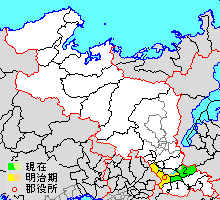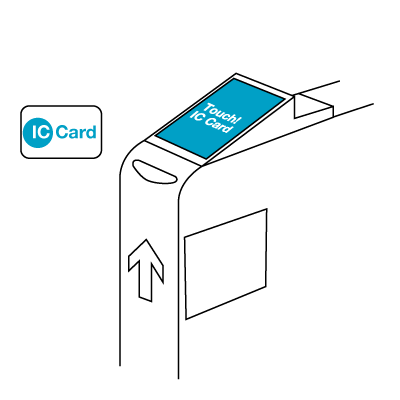|
Yamashiro-Taga Station
is a passenger railway station located in the town of Ide, Tsuzuki District, Kyoto Prefecture, Japan, operated by West Japan Railway Company (JR West). Lines Yamashiro-Taga Station is served by the Nara Line and is located at from the terminus of the line at and 16.4 kilometers from . Layout The station consists of two side platforms connected by an elevated station building. The station is unattended. A ticket machine is installed at the station. The IC card ticket " ICOCA" can be used at this station. Platforms History Yamashiro-Taga was opened on 15 July 1955. With the privatization of Japanese National Railways (JNR) on 1 April 1987, the station came under the control of JR West. Station numbering was introduced in March 2018 with Yamashiro-Taga being assigned station number JR-D15. Passenger statistics According to the Kyoto Prefecture statistical report, the average number of passengers per day is as follows. Surrounding area * Ide Town Taga Elementary Schoo ... [...More Info...] [...Related Items...] OR: [Wikipedia] [Google] [Baidu] |
JR Logo (west)
JR, J. R. or Jr. may refer to: * Jr. or Junior (suffix), a name suffix Arts and entertainment * ''J.R.'' (album), an album by Jim Bob * ''J R'', a 1975 novel written by William Gaddis * "Jr.", a song by Codeine on the album '' Barely Real'' * J. R. Ewing, a television character from ''Dallas'' * JR Chandler, aka Adam Chandler Jr, a television character from ''All My Children'' * ''Jornal da Record'', a Brazilian news program on RecordTV Businesses and organizations * Aero California, defunct Mexican airline by IATA code * Japan Railways Group or the JR Group, the main operators of the Japanese railway network * Jember railway station * John Radcliffe Hospital * Joy Air, Chinese airline by IATA code People In arts and entertainment * JR (artist) (born 1983), French artist * J.R. (musician) (born 1979), American Christian musician and producer * JR (rapper) (born 1987), South African rapper and entrepreneur * ''J. R.'' a pen-name of writer John Ruskin * ''Jr.'', stage name of Pa ... [...More Info...] [...Related Items...] OR: [Wikipedia] [Google] [Baidu] |
JR West
, also referred to as , is one of the Japan Railways Group (JR Group) companies and operates in western Honshu. It has its headquarters in Kita-ku, Osaka. It is listed in the Tokyo Stock Exchange, is a constituent of the TOPIX Large70 index, and is also one of only three Japan Railways Group constituents of the Nikkei 225 index: the others are JR East and JR Central. It was also listed in the Nagoya and Fukuoka stock exchanges until late 2020. Lines Shinkansen * Hokuriku Shinkansen ( - ) * San'yō Shinkansen * Hakata Minami Line :: Officially not a Shinkansen JR-West's highest-grossing line is the Sanyo Shinkansen high-speed rail line between Osaka and Fukuoka. The Sanyo Shinkansen alone accounts for about 40% of JR-West's passenger revenues. The company also operates Hakata Minami Line, a short commuter line with Shinkansen trains in Fukuoka. Urban Network The "Urban Network" is JR-West's name for its commuter rail lines in the Osaka-Kobe-Kyoto metropolitan area. These lines t ... [...More Info...] [...Related Items...] OR: [Wikipedia] [Google] [Baidu] |
Nara Line
The is a commuter rail line in the Osaka–Kobe–Kyoto metropolitan area, operated by the West Japan Railway Company (JR West). Its official termini are Kizu Station in Kizugawa and Kyōto Station in Kyoto, within Kyoto Prefecture; however, all trains continue past Kizu on the Yamatoji Line (Kansai Main Line) to Nara Station in Nara, Nara Prefecture. Overview The Nara Line is a part of the JR West "Urban Network" in the Kyoto-Osaka-Kobe area. Its primary role is that of an intercity-suburban commuter line, ferrying people to and from work and school in Kyoto and Nara; it is also well-used by tourists holding the Japan Rail Pass, as visiting the historical landmarks of Uji and Nara makes an easy day-trip from Kyoto. At Kyoto, the line connects to the Tōkaidō Shinkansen, the Tōkaidō Main Line (Biwako Line / JR Kyoto Line), and the San'in Main Line (Sagano Line), while at Kizu, it connects to the Kansai Main Line (Yamatoji Line) for , and the Katamachi Line (Gakkentoshi ... [...More Info...] [...Related Items...] OR: [Wikipedia] [Google] [Baidu] |
Railway Station
Rail transport (also known as train transport) is a means of transport that transfers passengers and goods on wheeled vehicles running on rails, which are incorporated in tracks. In contrast to road transport, where the vehicles run on a prepared flat surface, rail vehicles (rolling stock) are directionally guided by the tracks on which they run. Tracks usually consist of steel rails, installed on sleepers (ties) set in ballast, on which the rolling stock, usually fitted with metal wheels, moves. Other variations are also possible, such as "slab track", in which the rails are fastened to a concrete foundation resting on a prepared subsurface. Rolling stock in a rail transport system generally encounters lower frictional resistance than rubber-tyred road vehicles, so passenger and freight cars (carriages and wagons) can be coupled into longer trains. The operation is carried out by a railway company, providing transport between train stations or freight customer facilit ... [...More Info...] [...Related Items...] OR: [Wikipedia] [Google] [Baidu] |
Ide, Kyoto
is a town located in Tsuzuki District, Kyoto Prefecture, Japan Japan ( ja, 日本, or , and formally , ''Nihonkoku'') is an island country in East Asia. It is situated in the northwest Pacific Ocean, and is bordered on the west by the Sea of Japan, while extending from the Sea of Okhotsk in the north .... the town has an estimated population of 7,163. The total area is 18.04 km². Demographics Per Japanese census data, the population of Ide has declined in recent decades. References External links Ide official website Towns in Kyoto Prefecture {{Kyoto-geo-stub ... [...More Info...] [...Related Items...] OR: [Wikipedia] [Google] [Baidu] |
Tsuzuki District, Kyoto
is a district located in Kyoto Prefecture, Japan. As of 2003, the district has an estimated population of 19,200 and a density of 251.74 persons per km2. The total area is 76.27 km2. Towns and villages * Ide *Ujitawara is a town located in Tsuzuki District, Kyoto Prefecture, Japan. , the town has an estimated population Population typically refers to the number of people in a single area, whether it be a city or town, region, country, continent, or t ... Districts in Kyoto Prefecture {{Kyoto-geo-stub ... [...More Info...] [...Related Items...] OR: [Wikipedia] [Google] [Baidu] |
West Japan Railway Company
, also referred to as , is one of the Japan Railways Group (JR Group) companies and operates in western Honshu. It has its headquarters in Kita-ku, Osaka. It is listed in the Tokyo Stock Exchange, is a constituent of the TOPIX Large70 index, and is also one of only three Japan Railways Group constituents of the Nikkei 225 index: the others are JR East and JR Central. It was also listed in the Nagoya and Fukuoka stock exchanges until late 2020. Lines Shinkansen * Hokuriku Shinkansen ( - ) * San'yō Shinkansen * Hakata Minami Line :: Officially not a Shinkansen JR-West's highest-grossing line is the Sanyo Shinkansen high-speed rail line between Osaka and Fukuoka. The Sanyo Shinkansen alone accounts for about 40% of JR-West's passenger revenues. The company also operates Hakata Minami Line, a short commuter line with Shinkansen trains in Fukuoka. Urban Network The "Urban Network" is JR-West's name for its commuter rail lines in the Osaka-Kobe-Kyoto metropolitan area. These lines t ... [...More Info...] [...Related Items...] OR: [Wikipedia] [Google] [Baidu] |
Terminal Station
A train station, railway station, railroad station or depot is a railway facility where trains stop to load or unload passengers, freight or both. It generally consists of at least one platform, one track and a station building providing such ancillary services as ticket sales, waiting rooms and baggage/freight service. If a station is on a single-track line, it often has a passing loop to facilitate traffic movements. Places at which passengers only occasionally board or leave a train, sometimes consisting of a short platform and a waiting shed but sometimes indicated by no more than a sign, are variously referred to as "stops", "flag stops", " halts", or "provisional stopping places". The stations themselves may be at ground level, underground or elevated. Connections may be available to intersecting rail lines or other transport modes such as buses, trams or other rapid transit systems. Terminology In British English, traditional terminology favours ''railway station'' ... [...More Info...] [...Related Items...] OR: [Wikipedia] [Google] [Baidu] |
Side Platform
A side platform (also known as a marginal platform or a single-face platform) is a platform positioned to the side of one or more railway tracks or guideways at a railway station, tram stop, or transitway. A station having dual side platforms, one for each direction of travel, is the basic design used for double-track railway lines (as opposed to, for instance, the island platform where a single platform lies between the tracks). Side platforms may result in a wider overall footprint for the station compared with an island platform where a single width of platform can be shared by riders using either track. In some stations, the two side platforms are connected by a footbridge running above and over the tracks. While a pair of side platforms is often provided on a dual-track line, a single side platform is usually sufficient for a single-track line. Layout Where the station is close to a level crossing (grade crossing) the platforms may either be on the same side of the cross ... [...More Info...] [...Related Items...] OR: [Wikipedia] [Google] [Baidu] |
ICOCA
The card is a rechargeable contactless smart card used on the JR West rail network in Japan. The card was launched on November 1, 2003 for usage on the Urban Network, which encompasses the major cities of Osaka, Kyoto and Kobe (Keihanshin). It is now usable on many other networks. The ICOCA area has gradually been expanded, and now includes the San'yo region through the Okayama and Hiroshima urban areas, and some lines in northern Shikoku, San'in and Hokuriku regions as of 2020. ICOCA stands for IC Operating CArd, but it is also a play on the phrase , an informal, Kansai dialect invitation meaning "Shall we go?" in Japanese (the standard, Tokyo dialect equivalent is ). The mascots for the ICOCA program consists of a blue platypus (or duckbill) called and . Functions/services Usage of the card involves passing it over a card reader. The technology allows for the card to be read at some distance from the reader, so contact is not required, and many people leave the card ... [...More Info...] [...Related Items...] OR: [Wikipedia] [Google] [Baidu] |
Japanese National Railways
The abbreviated JNR or , was the business entity that operated Japan's national railway network from 1949 to 1987. Network Railways As of June 1, 1949, the date of establishment of JNR, it operated of narrow gauge () railways in all 46 prefectures of Japan. This figure expanded to in 1981 (excluding Shinkansen), but later reduced to as of March 31, 1987, the last day of JNR. JNR operated both passenger and freight services. Shinkansen Shinkansen, the world's first high-speed railway was debuted by JNR in 1964. By the end of JNR in 1987, four lines were constructed: ; Tōkaidō Shinkansen: , completed in 1964 ; Sanyō Shinkansen: , completed in 1975 ; Tōhoku Shinkansen: , as of 1987 ; Jōetsu Shinkansen: , completed in 1982 Buses JNR operated bus lines as feeders, supplements or substitutions of railways. Unlike railway operation, JNR Bus was not superior to other local bus operators. The JR Bus companies are the successors of the bus operation of JNR. Ships JNR o ... [...More Info...] [...Related Items...] OR: [Wikipedia] [Google] [Baidu] |

.jpg)

